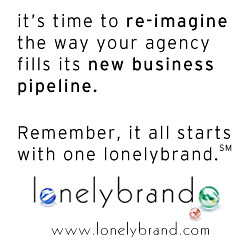
In follow up to B.L. Ochman's article in AdvertisingAge entitled "Nine Great Reasons to Blog" I thought I would add my two cents. Clients are asking more and more about how best to create and maintain a blog, and aside from the obvious caveats about content and relevance, here are some outstanding reasons companies should make the investment.
There are some very pragmatic reasons your company should have a blog:
1) Search Engine Optimization. Search engines reward content that is not deeply structured (a blog usually consists of one HTML page) and frequently updated. A blog can ensure your company stays number one when a potential customer hits a keyword
2) Your competitors are doing it. I was just asked in a conference call with a large company to look at their competitors website, "Look at this, they have a personal CEO blog, a general PR blog, and a Flikr group! We want that!" My immediate response was, "What content do you have to offer? Give me something I can use to attract readers."
3) Your customers want it. A marketing manager at a large cinema group is using Twitter (a microblogging service) to give away free movie schwag (film posters, premier tickets, etc...). He got a modest initial following from the giveaways, but noticed something interesting. His dissatisfied customers were using Twitter to let him know they had a bad experience. He was able to bring these angry customers back into the fold by offering complementary tickets, a quick word of apology, or an explanation of company policy. The point is these customers were able to quickly issue feedback through the blog that is reviewed by peers and gave the company a chance to reduce attrition.
In addition, there are other - less tangible - benefits from having a company blog:
1) Your employees read it. Having a centralized place to deliver a more personal message can boost employee morale in tough times. Think of how C level bloggers have used their platform to discuss layoffs from an honest, no nonsense perspective, or how the same C level bloggers have congratulated individuals or groups within the company on better than expected performance.
2) Your company can create perception. Companies and individuals can use blogs as a way to self-brand. Choosing an author, imagery, rich media, and topics for articles allows you to actively manage your company perception. Individuals trust and seek out blog posting much more than press releases, and data from a blog cannot be bent through the lens of biased media groups. So long as the content remains honest, useful, and relevant to the audience a company may enjoy a high level of brand awareness without being literal.
3) Increase personal value. As an employee, your ability to manage and produce a successful blog increases your value. You have an opportunity to establish yourself as an informed and knowledgeable industry pro in a public forum. Encouraging employee contribution to the blog is a win win - individuals gain recognition and the company that employs them is increasingly viewed as having the best talent by customers and competitors alike.
Nicholas Kinports (follow him on Twitter @ADMAVEN) has worked in the interactive technology world for over 15 years. He is the Digital Strategy Lead and founder of Chicago-based digital marketing firm lonelybrand, where he directs the creation and execution of digital marketing programs that generate measurable signups, conversions and sales.









